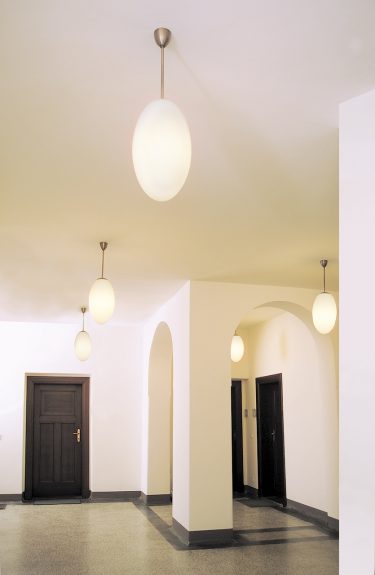With passion for Design
and a mind full of Tech
It all started in Berlin Kreuzberg
mawa design was founded by Martin Wallroth in 1977. In the Kreuzberg-based company, he developed and produced objects for living spaces. In the following years, the one-man business expanded and established as a professional company. At this time, the designs often pioneered formative ideas in product design.
New German Design
The eighties popularised an understanding of and interest in design. mawa design therefore broke new ground. In cooperation with external designers, product ideas for everyday life could be created and quickly implemented thanks to the flexible structure of the company. The product range finds its customers mainly in the upmarket retail trade.
From interior accessories to lighting series
In addition to the standard product range, the company’s own metal-working manufactory also produces luminaires according to individual specifications. The first small series and unique pieces are produced, e.g. for the Federal Chancellery, the Ministry of Economics, the Corbusier House, the Maxim Gorki Theatre in Berlin or for the Luther House in Wittenberg.
Renowned companies such as BMW, Daimler Benz, Jil Sander, KaDeWe, Sony or The Conran Shop work with mawa design when it comes to first-class lighting. The products are characterised by high-quality materials and excellent workmanship. They can be found in important collections of museums all over the world.

Ground-breaking for the Microfactory
1997 marked a change of scenery for mawa design: the relocation to Langerwisch near Potsdam. The Palmhof, a listed building that has been completely renovated, offers enough room for all the manufactory’s work areas. It is conveniently located, not only tranquil in the countryside, but also Berlin and Potsdam can be reached within a short time.


Homage to sustainable design
At the end of 2001, mawa design once again drew attention to itself with an interesting exhibition. In December 2001, architect Axel Schultes opened the exhibition »Three Berlin Luminaires« in the rooms of the renowned Berlin furniture shop »Modus«. The pendant lamp »havanna« was presented in addition to the floor lamps »schliephacke« and »ssymmank«, which have already become classics.
The »havanna« opal glass luminaire was designed by Prof. Dr. Braun-Feldweg in 1959. mawa design had included it in its luminaire range as a re-edition. At the same time, »Die Havanna von Braun-Feldweg« by Dr. Th. Heyden was published by the publishing house Form in the series Designklassiker. With its timelessness and story, the »havanna« joins the »schliephacke« and the »ssymmank« as the third luminaire in the »Berlin Series« by mawa design.
Publications

The fifties produced many classic icons of design. These include the »ssymmank« and »schliephacke« floor lamps, modern classics that can certainly be mentioned in the same breath as the famous works of Arne Jacobsen, Eero Sarinen or Charles and Ray Eames. The organic lamp by Scharoun’s assistant Günter Ssymmank is now in the Museum of Modern Art in New York. This luminaire is a sensation even for the fifties, with its lamp head made of six brightly colored sheets of nylon. The multifunctional »schliephacke« by architect Fridtjof Schliephacke is completely different: with its reduced formal language, it unmistakably harks back to the design traditions of the Bauhaus. The book also includes two guest comments; Marcus Botsch on the »schliephacke« and Prof. Volker Albus on the »ssymmank«.
Publisher: jovis
Editor: Martin Wallroth
Author: Nora Sobich

havanna, mondello and tokyo – the high-quality reeditions of the Wilhelm Braun-Feldweg luminaires by the mawa design high-tech manufactory. More background information is available in this wonderful book.
Download book The Havana – Pendant lights by Wilhelm Braun-Feldweg

The exhibition “…everything depends on the lighting…” shows three reading lights designed and developed for libraries by Werkbund members Max Dudler and mawa design.
The most important thing about a good library is that the lighting complies with standards and needs. Light contributes significantly to a pleasant environment and thus to a high quality of stay, helps with orientation and structuring of areas and creates optimal working conditions for users and staff. The three reading lights not only meet all requirements, they also combine timeless design with technical innovation.

It is all because of Nils
Because of international orders, a growing assortment and increasing demand, the Palmhof has reached the limits of its capacity. Nils Holger Moormann, who has been a companion for many years, a veteran of the German furniture scene and a loyal friend of mawa design, calls a spade a spade: You need more space.
So, in 2012 a production hall is purchased. Sales and administration can spread out in the Palmhof. From now on, planners, designers, and technicians work in the village Seddiner See, ten minutes away.
However, the CNC machine tools multiply so quickly that an annexe is built after only five years. The company’s own lighting laboratory with Goniophotometer is set up under the roof of the new building made of overseas containers.
Green light for further growth
With the own design department, research and development, as well as an own lighting laboratory, the company is now one of the preferred partners of international specialist planners. mawa design has advanced from being an insider tip to a leading brand, especially in museums, libraries, sacred buildings and architectural monuments with minimalist lighting tools.
The significance of the company in the professional world is marked by a new branding with a distinctive logo. Here, too, the design principle is: less is more. And so, in 2017, the brand name is reduced to two syllables: mawa design becomes mawa. Only colour and attitude remain unchanged in green.

With the start of construction of a second hall in Seddin, mawa became even greener from 2020. The space gained will not be used to increase sales, but rather to produce even more resource-efficiently, more effectively: durable, long-lasting luminaires and systems.







